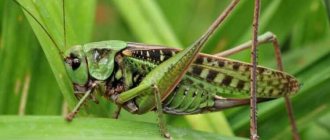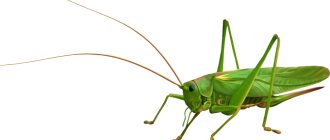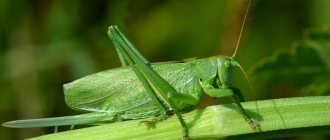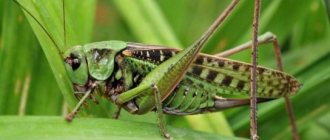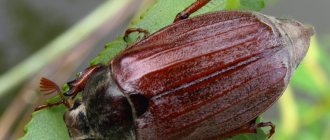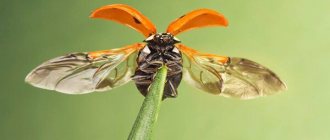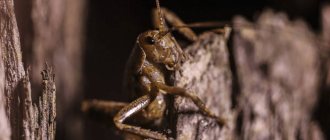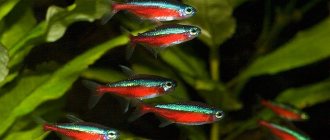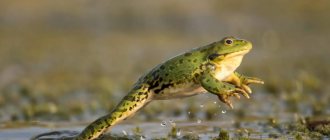The green grasshopper is a beautiful large insect of bright green or light green color with long translucent wings. Residents of Russia are well acquainted with the green grasshopper, as it lives in almost all landscape areas of the country. Only the climatic conditions of the northern regions are unfavorable for its existence.
The characteristic natural color serves as an excellent means of camouflage for the green grasshopper, which lives mainly in grasses and bushes. From mid-summer to late autumn it can be found in gardens, on the edges of forests, along the edges of fields and meadows. In desert areas, the green grasshopper prefers the edges of tugai forests and river valleys. In Central Asia, it climbs high into the mountains to hide in gorges with lush herbaceous plants. This insect can also be found in many other countries: in European countries (except for Northern European countries), Mongolia, Northern India, countries of Western Asia, Afghanistan, Western China.
Description of the appearance of the insect
The body of an adult insect, like the body of a larva, has a rich green color. Only on the wings and chest there may sometimes be dark spots. Body length – 28–36 mm. The antennae are very long, bristle-like, with a reddish tint. The length of the green grasshopper's whiskers exceeds the length of the insect's body. The grasshopper has 2 pairs of wings - front and rear. The hind wings are wide, transparent, with thin veins forming an abstract geometric pattern; the front ones are denser and narrower. At rest, the hind wings are hidden under
In front of them. The length of the wings exceeds the length of the insect's abdomen by almost 2 times. The head has an elongated shape. The eyes are round and protruding. The upper part of the pronotum has a convex or flat shape. The type of mouthparts is gnawing.
Females differ from males in the presence of a long saber-shaped or xiphoid ovipositor compressed from the sides. The hind limbs of males are much longer than the forelimbs. The hearing organs are oval membranes located on the shins of the forelimbs on both sides. In males, the elytra are equipped with a chirping organ, which is formed by a stridulatory part and a transparent resonating membrane (speculum).
Why do grasshoppers sing?
A common feature of the male grasshopper is the insect’s amazing “singing ability.” The green jumper has a stridulatory apparatus that, when rubbed, produces loud chirping sounds familiar to every person. The structure of the apparatus includes a dense vein dotted with chitinous notches. It is located at the base of the left elytra. That's not all. At the base of the right elytra there is a thin membrane with a rigid edge. When the wings move, both devices begin to move. They touch each other, causing the wings to tremble in a fine vibration.
The loud sound, heard 80-100 meters from the warbler, is not created without intention. Thus, males make themselves known to females in the area. The more musically the grasshopper demonstrates its presence, the more likely it is that some female, attracted by the chirping, will come to the call.
Lifestyle
Green grasshoppers lead a solitary lifestyle. They jump and fly very well.
The length of the jump is several times greater than the length of the insect itself, and the flight speed can reach up to 1.5 km/h.
Grasshoppers do not have a home; they are always found among grass, bushes and trees. In particularly hot weather, the insect hides in the greenery all day, emerging from shady shelters only early in the morning.
We hear the ringing melodies of the grasshopper throughout the summer. The sound occurs as a result of vibration and becomes even louder if the insect raises its wings. Males sing to attract females or to let other males know that the territory is already occupied. The chirping of a grasshopper can most often be heard in the daytime and evening, less often at night.
Habitat
It is believed that the spread of grasshoppers originated from the Eurasian steppes, from where these insects spread everywhere. You can now meet the green singing baby in the Far and Middle East, Africa, England, Denmark, Finland and even, recently, in the Alps. Grasshoppers prefer to settle in open spaces, avoiding shaded places, so it is not easy to find one in a dense forest. And this despite the fact that the creatures cannot stand the heat at all and hide in the grass until the sun goes down!
Reproduction
Mating of green grasshoppers occurs within 45 minutes. After mating, the female begins to eat the spermatophore. This process can last up to 15 hours. The male resumes his chirping within 15 minutes after mating.
Egg laying occurs at the end of summer. To do this, the female selects a suitable place in the soil and lays up to 100 eggs in a shallow hole. The eggs are elongated, cylindrical, greenish in color. Egg length up to 6 mm.
Adults die with the onset of cold weather, and the eggs continue to be in the soil at a shallow depth throughout the fall and winter. In the spring, when the surface layer of the earth begins to warm up, larvae hatch from the eggs. During their development, they molt 5 times. Then, bypassing the pupal stage, the larva will turn into a young grasshopper.
Harm and benefits of green grasshopper
Many gardeners, seeing an abundance of grasshoppers in their summer cottage or vegetable garden, try to remove them. Usually, remedies for harmful bugs are used. The main goal that people pursue is to prevent insects from breeding. In part, these fears are not unfounded. After all, the larvae that hatch from the eggs eat all day long, and during the first molt, their food becomes precisely fresh young greens.
However, the complete absence of a grasshopper during all periods of its development threatens such an unpleasant consequence for the beds as an increase in the number of phytophages - insects that feed exclusively on plants. And if the presence of a green grasshopper can still be tolerated, the presence of herbivorous creatures will definitely not contribute to a good harvest.
Basically, all the fears of farmers who take sometimes unjustified measures to drive the jumper out of their crops are based on the physiological similarity of the two types of insects. The grasshopper (see photo below) looks like a dangerous pest - a locust. Despite the fact that insects are clearly different from each other, many business owners are intensively reducing the number of both of them with the same intensity.
Insect nutrition
Green grasshoppers are predatory insects. They feed mainly on butterflies,
caterpillars and other small insects, sometimes eating larvae or weaker representatives of their species. Grasshoppers wait for their prey, sitting quietly in the grass, grab it tightly with their 4 front legs and immediately eat it.
If difficulties arise in finding insects, grasshoppers can feed on plant foods: flowers, foliage, tree buds, plant stems, grass and some cereals.
Ball-headed grasshoppers
Otherwise called fat people, because they have a fleshy, wide body. The head of insects, as the name implies, is spherical. Its antennae are set below the eyes. Ballheads also have shortened elytra. The hearing organs are located on the front legs. There are cracks visible. These are the ears.
Sevchuk Servilya
This is a medium-sized grasshopper. The two-centimeter body of the insect is dense, wide, and looks short. The grasshopper is painted brown. The flattened pronotum has yellow markings.
The lateral carinae of Serville are pronounced. By the way, the insect was named after an entomologist from France. Guyom Odinet-Servile devoted his life to the study of Orthoptera.
Sevchuk servilla received its name in honor of the French entomologist
Fat guy
The species is European, on the verge of extinction, included in the species of large grasshoppers . Males of the species are 8 cm long. The length of females is 6 centimeters.
The names of grasshoppers are often based on their appearance. A fat man, for example, looks plump, even fat. Due to this, the visually black-brown body of the insect appears shorter. Volume is also added by sharp keels on the sides of the grasshopper's pronotum.
Fat grasshopper
Maliciousness
Very often, the green grasshopper damages vineyards by eating flowers, leaves and buds. The grasshopper often harms tobacco crops, citrus fruits, tea leaves and other plants.
The most dangerous caterpillar, contact with which can lead to death, is Lonomy. Have you planted a beautiful boxwood bush and are afraid for its safety? Find out how to protect your plant from its biggest enemy. Read more here.
If you need to treat indoor or garden plants against spider mites, then choose Masai acaricide. What are its advantages, read the link.
Green tetigonia grasshopper - description, photo and video
Green tetigonia grasshopper - description and video of the night guest! And what just doesn’t happen in life. This happened to us too. Hot summer night in 2012 - all the windows are wide open to get at least a little coolness. So, at half past one in the morning, an uninvited guest flew into my wife’s room. My wife woke up from a rustling sound and a cracking sound above her head. She watched with fear as something circled just above her face, now approaching and then moving away.
Then this “something” fell on the bed, ran over him and hid between the bed and the wall. A frightened woman jumped out into another room and woke me up in fright: “There’s something flying and rustling in my room,” my wife almost cried. “Find it and throw it away,” she begged.
The first thing that came to mind was a bat. She was probably hunting insects and accidentally flew into the room. I took a mitten just in case and went hunting. I searched under the bed and furniture for a long time and found the cause of the commotion. It turned out to be a huge, with a total length of 7 cm, green tetigonia grasshopper.
Green tetigonia grasshopper - description, photo and video
Quite strong, aggressive and self-confident, when I caught him, he bit into my finger with his strong jaws, releasing drops of thick brown liquid. But here he did not succeed, I put on the glove. I took it out to the balcony, covered it with a jar and left it until the morning.
What a surprise it was in the morning when I went out onto the balcony. The grasshopper was not there! More precisely, the bank stood there, but the grasshopper was not there. Strong paws allowed him to get out from under the can, and he himself climbed along the balcony.
Later, after searching on the Internet, I realized that the Green Grasshopper Tettigonia or, as it is also called, the True Green Grasshopper (Tettigonia viridissima Linnaeus, 1758) had come to us. The method of movement chosen by green grasshoppers is difficult to explain logically.
Although they are one of the best long-distance jumpers, to overcome them, grasshoppers are more likely to slowly climb plants or fly from place to place rather than jump.
Green tetigonia grasshopper in all its glory:
In summer, from the trees and thickets of bushes, the loud melodies of males can be heard. Green grasshoppers are most active in the late afternoon and at night. At this time they feed. Like most representatives of the Orthoptera series, green grasshoppers are omnivores.
Most of all they like soft, juicy parts of plants and animal food. The green grasshopper is a predator and feeds mainly on insects and their larvae. Having discovered prey with the help of long sensitive antennae, it immediately catches it with its paws and then uses its mouthparts. Sometimes the grasshopper is confused with its close relative, the locust.
Migratory Asian locust - compare with the titigonia grasshopper - they are different. Illustration source:
How are grasshoppers different from locusts?
So how do they differ from each other? The horse is a predator and can bite quite painfully. Locusts are herbivores and eat only greenery (leaves, stems, flowers, fruits). The grasshopper's whiskers are longer than those of the large locust.
And the grasshopper's abdomen is short, and the locust's abdomen is long. All grasshoppers fly into bright light, but locusts do not care about light. Grasshoppers sit on twigs, tall blades of grass, bushes and trees, while locusts prefer the ground. Grasshoppers hunt at night, while locusts are active during the day.
This is what locusts look like - look at the photo of locusts:
Maybe this explains how the Green Tetigonia Grasshopper ended up on the 7th floor level. Or he climbed up the wall, flew into the reflection of light on the glass, it’s unclear. The main thing is that such an incident happened and my wife will remember this restless grasshopper for a long time with “kindly, quiet words”...
But that wasn't the end of the story.
When I released the grasshopper on the balcony, it opened its wings and flew with a crash. He made a U-turn and rushed towards the river, and a sparrow immediately rushed after him. I didn’t see how it all ended, but I think the grasshopper didn’t reach the greenery... Did you like the article? Share with friends on social networks:
Control measures
Methods to combat this insect have not yet been sufficiently developed. For preventive and exterminatory purposes, the following is recommended:
- It is advisable to locate tobacco plantations away from egg-laying sites (thrush and virgin areas) of the green grasshopper;
- treatment of the shag field and surrounding area with internal poisons;
- placement of bait with poison in pest habitats. This will require 30–60 kg of bran, 24 liters of water, 0.8–1.2 kg of arsenous soda.
Greenhouse grasshoppers
They are hunchbacked and stocky. The body of greenhouse grasshoppers is shortened, but females have a long ovipositor. Representatives of the genus are also distinguished by long legs and mustaches. The latter reach 8 centimeters.
Chinese greenhouse grasshopper
A little less than 2 centimeters in length. The shortened body surrounded by long, thin legs makes the insect look like a spider.
The Chinese grasshopper is painted brown. There are dark spots. They, like the rest of the body, are covered with short, silky hairs. The insect sheds them, along with its chitinous shell, about 10 times during its life. This is a record for grasshoppers.
Far Eastern grasshopper
Included in the grasshopper species of Russia . The insect is otherwise called a cave insect, since it settles not only in greenhouses, but also in karst rock cavities.
The Far Eastern grasshopper is medium-sized, brown-gray in color. The insect is nocturnal. This distinguishes the species from most grasshoppers.
Mormon Grasshopper
This species is classified as an insect pest, as it is capable of destroying plants specially planted by humans. Another difference between the “Mormon” is the size. Its length can reach 8 centimeters. It lives in North America, mostly in pastures, where it actively eats plant matter. This grasshopper often makes long migrations, covering a distance of up to two kilometers per day. However, he cannot fly.
Dybki
There is one species in the genus. In Russia, its representatives are the largest grasshoppers. The hindquarters are green and have light stripes on the sides. The elongated body reaches a length of 15 centimeters.
Steppe rack
She's a predator. Among grasshoppers there are also herbivores. Predation does not help the steppe rack to survive. The species is considered endangered.
Steppe bucks have no males. Females use partonogenesis. Eggs are laid and develop without fertilization. Other grasshoppers are not capable of this.
The steppe racket is listed in the Red Book of Insects
Exotic grasshoppers
There are species of grasshoppers that are hardly recognized as such. It's about unusual shapes and colors. Non-standard grasshoppers usually live in the tropics.
Peruvian grasshopper
Opened in 2006 in the mountains of Guyana. The grasshopper imitates the color of a fallen leaf. Externally, the insect also resembles it. The outer side of the folded wings is dotted with a grid pattern. It repeats the capillary pattern on dried greenery.
In order to resemble a fox in shape, the grasshopper folds its wings, covering the sides and a large space above the back.
The underside of the wings of the Peruvian grasshopper is colored like the Peacock butterfly. She chose this design to scare away predators. Seeing “eyes” on the wings of an insect, they mistake it for a bird or other animal. The Peruvian grasshopper uses the same trick. It also bounces characteristically to resemble the head of a large bird.
The Peruvian grasshopper opens its wings and looks like a butterfly.
Grasshopper rhinoceros
It also resembles a leaf, but green. The color is juicy, closer to light green. The insect's antennae are line-like threads. They are barely noticeable, translucent, significantly longer than the body.
The name of the insect is associated with the presence of a horn-like structure on its head. It is also green, attached to the back of the head, like a leaf stalk.
Spiny Devil
Looking at the types of grasshoppers in the photo , it’s hard not to stop looking at the devil. It is emerald in color and covered with triangular needles. They are located all over the body.
The length of the devilish grasshopper does not exceed 7 centimeters, although it is a tropical inhabitant. However, the sharp needles and the insect's manner of waving its limbs in front of its enemies scare away the latter. The devil does this in the forests of the Amazon basin.
Spiny devil grasshopper
Exotic grasshoppers are also found among ordinary ones. Here it is no longer a matter of species, but of genetic anomalies. In the world of grasshoppers, erythrism occurs. This is the absence of pigment. Erythritated grasshoppers resemble albinos, but not the former ones. Pink coloring occurs in one individual out of 500. Erythrism in grasshoppers was discovered in 1987.
Finally, we note that in the eyes of ordinary people, grasshoppers are not only true representatives of the suborder, but also crickets and fillies. The latter have shorter antennae and stockier bodies. Crickets have a spherical head and a flat and short body.
Orthoptera pests
Many representatives of the order damage crops such as corn, cucumbers, and potatoes. Thus, locusts can destroy fields in a short time. Herds fly 100 km a day to get a treat.
In addition to all types of locusts, dangerous pests include the mole cricket and the Italian locust. Mole crickets love to gnaw on root crops; sometimes a few insects reduce the harvest by half. Another dangerous orthopteran is the green grasshopper, which gnaws out grape buds and eats flowers. It harms not only grapes, but also oranges and lemons.
Peacock grasshopper
This grasshopper received this name because of the pattern on its wings. When raised, they actually vaguely resemble a peacock's tail. The grasshopper uses its bright colors and unusual decoration on its wings as a psychological weapon. If there is danger nearby, the wings rise vertically, imitating the large size of the insect and huge “eyes”.
